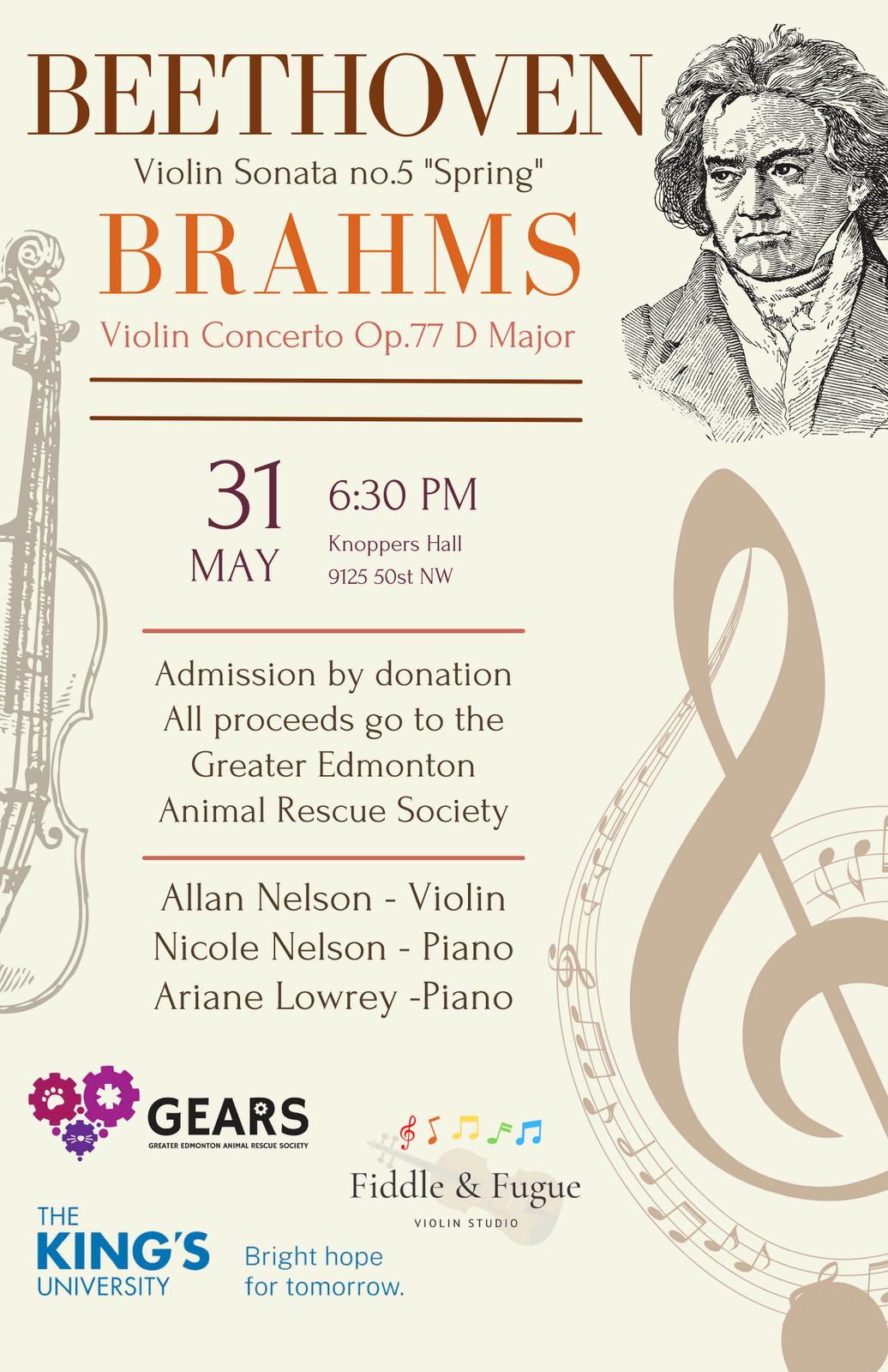




BEETHOVEN VIOLIN SONATA NO.5 “SPRING (25 MIN)
ALLAN NELSON (VIOLIN)
NICOLE NELSON (PIANO)
I. ALLEGRO
II. ADAGIO MOLTO ESPRESSIVO
III. SCHERZO
IV. RONDO
INTERMISSION (5 MIN)
BRAHMS VIOLIN CONCERTO IN D MAJOR (38 MIN)
ALLAN NELSON (VIOLIN)
ARIANE LOWREY (PIANO)
I. ALLEGRO NON TROPPO
II. ADAGIO
III. ALLEGRO GIOCOSO

The Greater Edmonton Animal Rescue Society (GEARS) was formed in 2013 to help injured, abandoned, unwanted, and homeless animals. GEARS is a non-profit organization that relies on a network of donors, volunteers and foster homes working together to give companion animals a second chance at their forever family. With high standards of practice and charitable status, GEARS sets an example in our community. Compassion motivates us to help, heal, and alleviate the pain of the animals we encounter.
For over 40 years, The King's University has been committed to the highest level of excellence in teaching and research with the belief that a robust liberal arts offering underpins disciplinary learning. Building a Christian learning community where all belong and flourish has been a top priority for the university since it was founded in 1979. King's strives to make a transformative impact on the world. Renewal and reconciliation in every walk of life is possible and King's helps to achieve this vision by equipping learners professors and students alike to contribute to the public good and advancement of God's Kingdom.
As one of the premier violin studios in Edmonton, Fiddle and Fugue offers students across Edmonton and beyond the chance to learn in an inclusive space that encourages imagination, passion, and artistry. Fiddle and Fugue has worked to raise thousands of dollars for local animal charities, with the belief that music builds, and strengthens community.

Allan Nelson was raised in a musical family that loved to listen to bluegrass and country artists. As a teenager he found a passion for both violin performance and fiddling and has been playing ever rently, he is the Associate concertmaster of the Concordia Orchestra, Owner of Fiddle and Fugue violin studio, and is a aduate of The King’s University. Allan has been invited to several prestigious competitions such as the 2019 Canadian ters fiddle championship, the Grand North American Fiddle on, and placed as the runner up in the Concordia Concerto n. He has been a recipient of: The Alan and Alice bell award e CSO award for outstanding musicianship and excellence in Gerry Segger award for performance excellence in 2022, the Strauss award for advanced study of music in Austria, the and Vera Shean scholarship, and the Winspear fund for d study of Classical music in 2023 Allan has studied with learning both the concerti and smaller works of the major assic and romantic, and modern composers, and has played masterclasses run by violinists Mark Fewer and Axel Strauss a recipient of several prestigious scholarships for his study In Vienna at the University of Arts and Music with Peter r, the Mozarteum summer academy in Salzburg with Phillip nd Bernard Hagspiegel and Myrto Aretaiou, and Amitri della stival in Italy under Ksenia Milas and Oleksander Semchuk.
Nicole Nelson has been playing piano for nearly two decades and she developed a strong love for performing through her regular participation in music festivals at both the local and provincial levels. Her notable musical achievements prior to her post-secondary studies include being the recipient of the Parkland Music Festival's Most Outstanding Pianist award for four years in a row, and being one of twelve young pianists accepted into Alberta Pianofest in 2017, where she was featured in a concert given by British pianist Murray McLachlan. Nicole is an alumna ('23) of The King's University, where she studied Piano Performance in the Bachelor of Music program. During her time at King's, Nicole received numerous academic and musical achievement scholarships, most notably the Gerry Segger Scholarship in Performance Excellence. She will be furthering her education this fall as a Master of Music student at the University of Victoria. While Nicole loves solo performance the most, she has a new-found love for collaborative work and is very excited to be performing this wonderful Beethoven sonata alongside Allan When she's not playing or teaching piano, Nicole can be found either reading, baking, or doting on her family's adorable pets.



The popular “Spring” Sonata did not get its nickname until after Beethoven's death. Yet while not authentic, it is quite appropriate for this sonata, characterized by a special warmth and serenity throughout its four movements. Written during 1800-01 together with the more tempestuous Sonata in A minor, Op. 23, it was published like its companion piece with a dedication to one of Beethoven's patrons, Count Moritz von Fries.
The first movement opens with one of Beethoven's most endearing lyrical melodies. Subsequent themes show a little more dynamic energy, but it is more like a gentle breeze rustling the leaves than a strong wind, let alone a storm. The secondmovement Adagio is based on a single melody of rare delicacy, played in turn by both instruments. Beethoven's shortest sonata movement, the scherzo, grows from a simple rhythmic idea, repeated constantly by the piano, with an off-beat response from the violin.. The final Rondo confirms the joyful and sunny atmosphere that has dominated the entire composition




Brahms’s Concerto emerged from the master’s highly productive summer of 1878. The genesis and growth of Brahms’s Violin Concerto owes to the composer’s friendship the great violinist, Joseph Joachim. This virtuoso musician, who also was a composer of no small ability, offered much more than merely technical advice to the composer. The Brahms-Joachim correspondence reveals much valuable insight into the concerto’s compositional genesis.
The magical moments in Brahms’s Violin Concerto are almost too numerous to count, but a few are worth noting. The first entrance of the solo instrument takes place in a highly charged and dramatic D Minor. Also worthy of mention is the gentle and lyrical reentry of the orchestra after the first movement’s cadenza one of several instances of the influence of Beethoven’s Violin Concerto (a work that was also performed, at Joachim’s insistence, at the premiere). Joachim composed and performed his own cadenza (still used by many violinists) for the first performance of the Brahms.
It is difficult to imagine a more sublime melody than the F-Major oboe solo that inaugurates the Adagio second movement. Indeed, the scoring for woodwinds and solo violin throughout this movement is incomparable.
The finale is a gypsy-inspired rondo filled with technical challenges aplenty, as well as metrical subtleties, but never exceeding Brahms’s customary decorum. The movement is rounded out by a piquant and exciting coda and violin pyrotechnics

